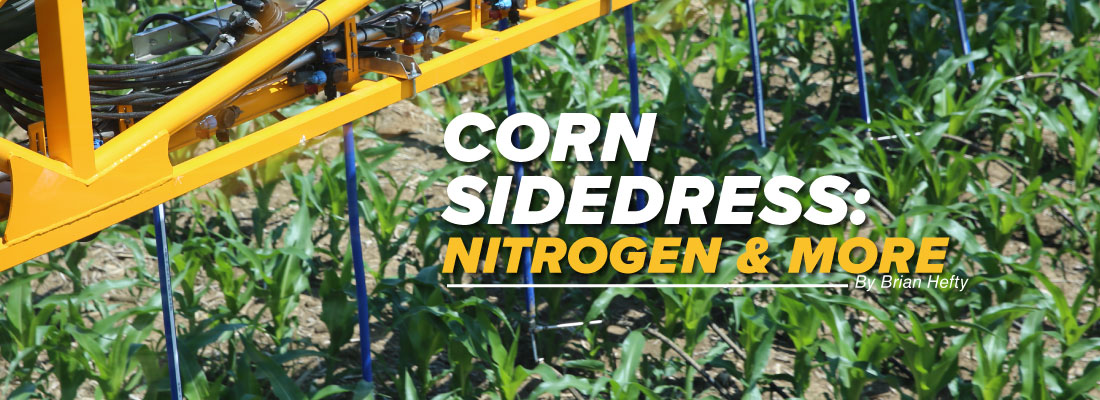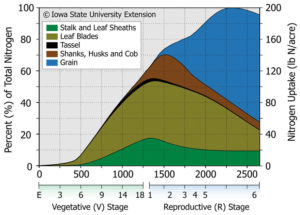
Big corn yields require lots of nitrogen, and you never, ever want to run short. Nitrogen is relatively cheap right now, and it’s pretty easy to apply some of this mobile nutrient at sidedress time and get it into the crop. Here are my top tips on how to apply the right amount of nitrogen and other nutrients while there is still time.
HOW MUCH NITROGEN DO I NEED?
I don’t care whose model it is, no one can predict with satellite imagery or computer programs exactly how much nitrogen you need. Quite frankly, no agronomist or soil fertility expert can predict it either, because no one knows exactly on each acre of your farm what your yield will be. A 20-bushel swing in yield means 22 pounds more or less nitrogen that could be needed. Nevertheless, you need to make your best estimate in terms of how much more nitrogen you should apply, so here are 3 things we want you to consider.
1. PULL A PRE-SIDEDRESS NITRATE SOIL TEST.
This test only costs about 5 bucks, and you don’t have to pull lots of tests across your farm to have a good idea how much nitrogen is out in your soil and ready for crop use today. Our suggestion is to pull some 0” to 12” samples and send them in for analysis about a week before you want to sidedress. Also, it’s a good idea to pull a few 12” to 24” samples because if you’ve got a lot of corn roots extending into your subsoil, your crop can probably pull up a bunch of that nitrogen, too, besides the shallow stuff.

To determine roughly how much nitrogen your crop needs, consider the crop’s nitrogen uptake.
2. WHAT IS YOUR YIELD ESTIMATE?
Keep in mind – areas of fields can vary wildly in terms of yield, so variable rate applications should definitely be considered. Whatever your yield goal is, the total nitrogen needed is 1.1 times that amount, so if the goal is 300, you need 330 total pounds of N throughout the season. To roughly figure out how much your crop needs from today through the rest of the year, look at the chart on the right showing when nitrogen is used by the corn plant during the season. At V9, the crop still needs to take up almost 80% of its total nitrogen!
3. ORGANIC MATTER MINERALIZATION.
I hear so many people talking about the myth of “soybean nitrogen credit”. There is no guarantee you magically have a bunch of nitrogen for your corn the next season just because you raised soybeans last year, especially if you had a lot of fall rain to leach that nitrogen away. What is real, though, is the organic matter in your soil will break down slowly over time and release nitrogen, phosphorus, and sulfur for this season’s crop. Assuming you are raising a full-season corn hybrid, you should be able to take advantage of most of the nitrogen that comes from your soil’s organic matter. If you’ve already figured out how much nitrogen you need based on yield and subtracted off what’s already in the soil, this is your last step. Simply subtract off your estimate of what will come available from organic matter. On our farm, we typically just multiply the organic matter level times 20, so if we have 5% organic matter, that’s approximately 100 pounds that will come available between now and October. In hot years, that figure will be higher due to better mineralization, but in cold, wet years that figure could be a hair lower. If you farm in Canada, multiplying 10 or 15 times your organic matter may be appropriate, while a figure of 25 to 30 could be right if you farm in Missouri or further south.
WHAT ELSE SHOULD I ADD TO MY SIDEDRESS BESIDES NITROGEN?
1. SULFUR. The old rule has been to add somewhere around 1 pound of sulfur for every 15 pounds of nitrogen, but Darren and I have talked about this and studied it a lot in the last couple of years. We think that figure is way too low. We are seeing lots of sulfur deficiencies, and we now believe the correct figure to be potentially as low as 8 to 1. In other words, if you want to add 80 pounds of nitrogen at sidedress, add 10 pounds of sulfur. Obviously, this can vary based on how high your sulfur levels are in your soil, but if you have low sulfur in the soil or in plant tissue, sulfur is easy to add when sidedressing. 4
2. BORON. Yes, you can foliar feed, and yes, too much boron can be toxic, but boron moves well in soil, so there’s no reason it can’t be applied at a low dose in your sidedress application. By low dose, we’re usually talking 1 to 2 pounds. Boron is safer when you have heavier soil with over 65% calcium base saturation. Boron rates should be cut if you have low calcium or sandier soils. Monitor your plant tissue levels using plant tissue analysis every Monday morning for the next few weeks to see if you applied enough, too much, or not enough boron. This will help you finetune your fertility program for next year.
3. POTASSIUM. If you have heavy soil, no irrigation, and you’re in a dry area of the country (like our farm), there’s zero chance I would ever recommend this. However, if you have light soil and either irrigation or high summer rainfall, this can actually work pretty well. Corn needs a crazy amount of potassium. At 1.35 pounds per bushel, that’s 405 pounds for 300-bushel corn! Does your crop have enough K every single day of the growing season? This is why we want non-irrigated, heavy soils loaded up before the season OR if you have light ground with irrigation, you can certainly add some K at sidedress. A lot of farmers are doing this now and having good responses in high-yield environments.
